Hydration Made Fun: 10 Kid-Approved Tricks to Get Kids to Drink More Water

Struggling to get your kids to drink enough water? Discover 10 fun and creative water tricks that make hydration exciting and healthy for children of all ages.
Introduction
Let's be honest, how many times a day do you find yourself singing the "drink your water!" chorus? If you're like most parents, it's a familiar tune. Getting our little ones to sip enough H2O can sometimes feel like a mini-battle, but what if it could be an adventure instead? Good news: it absolutely can!
Water is like a secret superpower for your child. It's the fuel that helps them zoom with boundless energy on the playground, think like a superhero in the classroom, and keeps their amazing bodies working like well-oiled machines. Most of their body is made of water, and it’s essential for everything from maintaining their temperature to helping their organs function day-to-day. Proper hydration is also key for regular digestion and can even help prevent issues like urinary tract infections. And get this – your child's brain is about 73% water! Staying hydrated helps them concentrate, boosts their memory, and keeps them sharp for learning. When children embrace water as their go-to drink, they are not just quenching thirst; they are unlocking their potential to feel great and perform their best. This positive association, built early, can also steer them away from sugary drinks, which can actually discourage water consumption and make them less hungry for nutritious foods.
So, how do we turn "drink your water" from a parental plea into a kid-driven quest? Get ready to dive into 10 fun, easy, and totally kid-approved tricks that will have your children reaching for their water bottles with a smile!
The 10 Kid-Approved Hydration Tricks
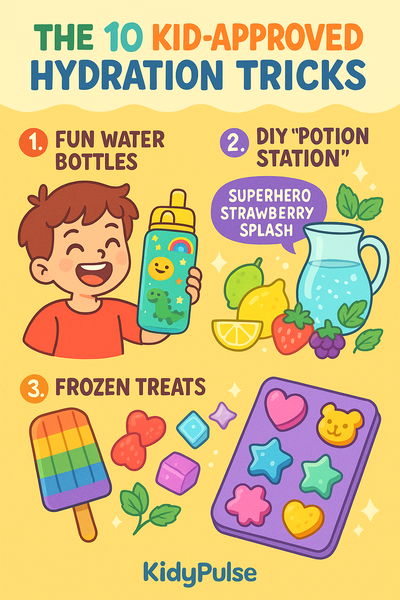
1. The "Choose Your Champion" Bottle
Forget plain old cups; a special water bottle can be a total game-changer! Think of it as your child's trusty sidekick, always ready for their next adventure. When a child has a bottle they love, they're far more likely to keep it close and sip from it throughout the day.
The magic lies in making it theirs.
- Let them lead the way: Take your child on a "water bottle adoption" mission and let them pick their own. This sense of ownership is incredibly powerful. When they choose it, they value it, and using it becomes their idea. This simple act of choice can lay the groundwork for developing a consistent hydration habit, as they take responsibility for their special bottle.
- Look for kid-appeal: Modern water bottles come in a dazzling array of designs. Think favorite cartoon characters, cool dinosaurs, sparkling unicorns, or vibrant patterns. Brands like Contigo, Hydro Flask, and CamelBak offer tons of options.
- Function meets fun: Seek out features that make drinking easy and exciting. Spill-proof and leak-proof lids mean fewer messes for you and more independence for them. Easy-to-use spouts, like those with AUTOSEAL® or AUTOSPOUT® technology, and handy carry loops for playground conquests are also big wins.
- Cool factor counts: An insulated bottle that keeps water refreshingly cold for hours can make a huge difference, especially on active days. And always opt for BPA-free materials for peace of mind. A "cool" water bottle isn't just about individual preference; it can even influence social dynamics. If carrying a fun, trendy bottle is seen as normal or even desirable among peers, it helps normalize choosing water, making it a positive part of their social experience at school or during activities.
2. DIY "Potion" Station (Fruit & Herb Infusions)
Transform plain water into a magical, flavorful "potion" that your little alchemist will be excited to create and drink! Infusing water with natural ingredients is surprisingly simple and a fantastic way to introduce new tastes.
It’s all about empowering them to experiment.
- Set the stage for discovery: Create a "potion station" with an assortment of washed and sliced fresh produce. Think colorful berries, zesty orange and lemon slices (consider removing the rind from citrus if infusing for more than a couple of hours, as it can make the water bitter ), refreshing cucumber, sweet pineapple chunks, and even fragrant herbs like mint, basil, or a sprig of rosemary. Explore some recipes here.
- Let them be the chef: Encourage your child to choose their own combinations. This hands-on involvement is key. They can pick out their favorite fruits at the supermarket and help with washing and adding them to the water. Maybe they'll invent "Superhero Strawberry Splash" or "Minty Melon Magic"!
- Visual appeal: Use clear pitchers or large mason jars so they can admire their colorful creations. Watching the fruits and herbs dance in the water adds to the fun.
- Patience for flavor: For a light taste, the infused water can be ready in about 30 minutes to an hour, but for a fuller flavor, let it steep in the fridge for at least a couple of hours, or even overnight. Remember to strain or remove the produce within 24 hours for the best taste and to ensure the water stays fresh for 3-4 days in the fridge. This "potion making" isn't just about hydration; it's a sensory adventure. As children mix and match, smelling and tasting different combinations, they're exploring flavors they might otherwise shy away from. This playful introduction can make them more receptive to trying new fruits, vegetables, and herbs in their meals, subtly expanding their palate and contributing to a more varied diet. Moreover, this activity taps directly into their imaginative play, turning a health habit into a creative learning experience about food and flavors.
3. Frozen Fun (Fruity Ice & Homemade Popsicles)
Who can resist a chilly, delightful treat, especially when the sun is shining? Freezing water in fun and fruity ways is a surefire strategy to boost hydration with a big dose of excitement.
This is "sneaky hydration" at its best!
- Jazz up your ice cubes: Add small pieces of fruit like berries, tiny citrus segments, or even edible flowers into your ice cube trays before freezing. These colorful, flavorful cubes make any glass of water look instantly more appealing. You can also freeze some berries whole to act as flavorful ice that won't water down their drink.
- DIY healthy popsicles: Blend fresh or frozen fruits (like strawberries, mangoes, or watermelon) with water, or a splash of no-sugar-added 100% fruit juice, and pour into popsicle molds. These homemade popsicles are a fantastic way to get fluids into your child, especially if they're resistant to drinking plain water. They see it as a treat, you see it as hydration success!
- Shape it up: Use ice cube trays in fun shapes – stars, hearts, animals, or even their favorite characters – to add an extra layer of playful charm. The appeal here goes beyond just taste. For many children, the cold temperature and unique texture of frozen treats are a big draw. Offering water in these varied forms caters to their sensory preferences, making hydration more engaging than just a standard glass of water. This approach is particularly effective for picky drinkerscolorful rainbow recipes kids, as the "treat" factor can overcome initial resistance to water.
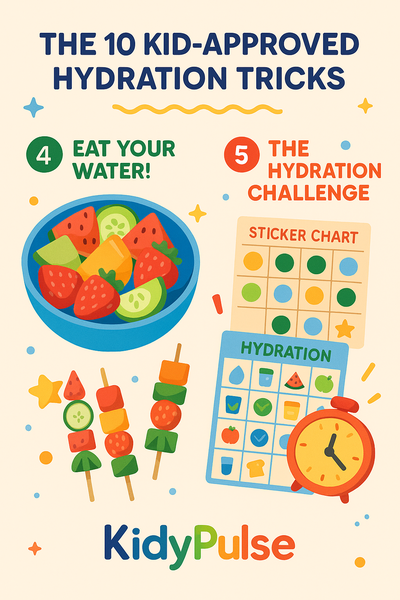
4. Eat Your Water! (Hydrating Snacks)
Hydration doesn't only come from a glass or bottle! Many delicious and kid-friendly foods are packed with water, contributing significantly to your child's daily fluid intake.
Think of these as edible water sources!
- Serve up juicy goodness: Offer snacks like crisp watermelon wedges, sweet cantaloupe or honeydew chunks, juicy strawberries, refreshing pineapple slices, and crunchy cucumber sticks. Oranges and peaches are also excellent hydrating choices.
- Make it colorful and fun:
- Create vibrant fruit salads.
- Assemble fruit kebabs with a mix of their favorite hydrating fruits – they're fun to make and eat.
- Use sliced cucumbers, carrots, or bell peppers (which also have good water content) instead of chips for dipping into hummus or a healthy yogurt dip.
- Blend it up: Whip up a hydrating smoothie using fruits like mango and pineapple, perhaps with some spinach (its taste is easily masked by fruit) and a bit of water or milk. By incorporating these water-rich foods into regular meals and snacks, you're providing another pathway to good hydration, reducing the sole pressure on drinking liquids. This approach also normalizes the consumption of these healthy foods for their overall nutritional benefits, with hydration being a fantastic bonus. The way these foods are presented matters too; making them visually appealing with fun shapes or arrangements, like fruit kebabs, can significantly increase a child's willingness to eat them, turning snack time into a hydrating and nutritious win. Discover more about fostering a varied diet.
5. The Hydration Challenge (Gamify It!)
A little friendly competition or a tangible sense of achievement can transform water drinking from a mundane task into an exciting game.
Turn sipping into a playful pursuit!
- Sticker power: Create a simple sticker chart. Your child earns a sticker each time they finish a designated amount of water (e.g., a small cup or half their water bottle). When they collect a certain number of stickers, they can earn a small, non-food reward or a special privilege. The visual progress of seeing stickers accumulate provides immediate positive feedback and builds their confidence in meeting the goal.
- Hydration Bingo: Design bingo cards with squares like "Drank water after playing outside," "Had water with breakfast," "Tried a new fruit in my water," or "Refilled my bottle without being asked."
- "Beat the Clock" (gently!): For older kids, a gentle challenge to finish their water by a certain, reasonable time – say, before their favorite TV show ends or by the end of a car ride – can add a bit of fun.
- Sibling rivalry (the healthy kind!): If you have more than one child, a lighthearted "who can finish their (small) serving of water first?" race can be surprisingly motivating. By framing hydration as a game, you tap into a child's natural love for play, achievement, and even competition. This shifts the motivation from external prompting by you to an internal desire to "win" the game or earn that next sticker. This sense of accomplishment can be very powerful in building positive habits.
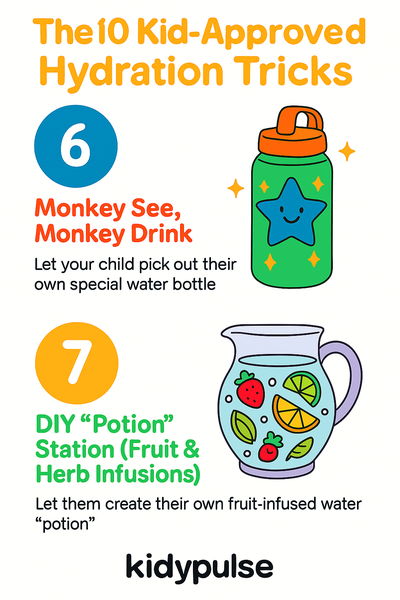
6. Monkey See, Monkey Drink (Be a Role Model)
Your little ones are always watching and learning from you. One of the most effective ways to encourage them to drink water is to show them that it's a normal, enjoyable part of your day too. Learn more about how to(https://kidypulse.com/us/blog/parents-tips/lead-by-example-how-adult-behavior-shapes-child-development).
Your habits speak volumes!
- Walk the talk (or sip the sip!): Carry your own water bottle and make a point of drinking from it regularly throughout the day, especially when you're with your child.
- Choose water yourself: When you're out at a restaurant or grabbing a drink, let your child see you choosing water over sugary sodas or juices.
- Positive water talk: Make positive comments about water, like "Ah, this water is so refreshing after our walk!" or "I feel so much better when I drink enough water."
- Make it a family affair: "Cheers" with water glasses at dinnertime. Make filling up everyone's water bottles part of your morning routine or before heading out for an adventure. When children see their parents consistently choosing and enjoying water, it sends a powerful message that water is the standard, preferred beverage for everyone in the family, not just a "kid rule." This consistency helps to avoid any perception of a double standard. Over time, these shared habits can become small family rituals, like everyone grabbing their water bottles before a park visit, transforming hydration from an individual task into a shared family value and strengthening your connection.
7. Water on Demand (Easy Access Everywhere)
The old adage "out of sight, out of mind" is especially true for busy kids engrossed in play. Making water incredibly easy for your child to find and reach is a simple but highly effective strategy.
Convenience is king!
- Strategic placement: Keep filled water bottles or kid-friendly jugs of water in easily accessible spots around the house: on a low shelf in the fridge, in their play area, on their nightstand (if age-appropriate).
- Always packed: Ensure a water bottle is packed in their school bag every day and for any outings, sports practices, or playdates.
- Kid-friendly water station: Set up a designated spot with small, manageable cups or their special water bottles that they can access independently.
- Right tools for little hands: For younger children, ensure they have sippy cups, cups with built-in straws, or small, lightweight bottles they can easily handle. When water is readily visible and accessible, it acts as a constant, gentle reminder. It significantly lowers the effort required for them to take a drink, making them more likely to sip frequently, even without being prompted. This easy access also helps children become more attuned to their body's natural thirst cues over time. Since thirst itself can be a sign that dehydration has already begun , having water always at hand encourages them to drink proactively, fostering better self-regulation of their fluid intake – a valuable skill for life.
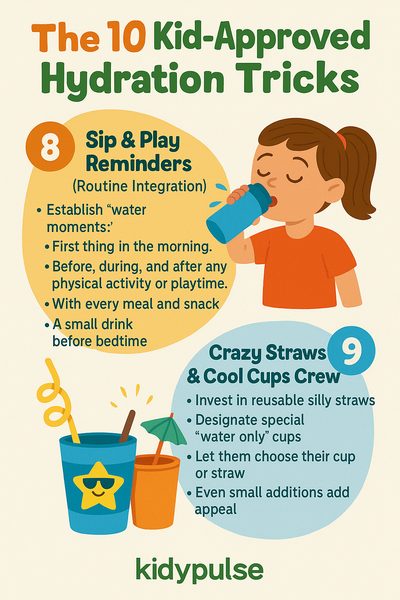
8. Sip & Play Reminders (Routine Integration)
Weaving water breaks into the natural rhythm of your child's day can make hydration an automatic habit rather than an afterthought.
Link water to what they're already doing!
- Establish "water moments": Make it a routine to offer water at specific times:
- First thing in the morning.
- Before, during, and after any physical activity or playtime. This is crucial as they need extra water when exercising or in hot weather to replace what they lose through sweat.
- With every meal and snack.
- A small drink before bedtime.
- Use gentle prompts: Link reminders to transitions in their day. "Playtime's winding down, let's grab a water refill!" or "Lunch is ready, time for water!"
- Part of the gear-up: If they're heading outside to play, make grabbing their water bottle as routine as putting on their shoes or a hat. By "stacking" the habit of drinking water onto existing routines, it becomes more automated. The established activity (like finishing a meal or coming inside from play) acts as a trigger for the water break, requiring less conscious effort from both you and your child. Specifically associating water with physical activity helps children learn about their body's increased needs during exertion. They begin to understand that their body needs refueling with water when it’s working hard, fostering an early awareness of self-care and physiological needs that is vital for lifelong health.
9. Crazy Straws & Cool Cups Crew
Sometimes, the secret to more sips lies in the sheer fun of the drinking vessel! While a special on-the-go bottle (Trick 1) is great, having a dedicated collection of fun cups and straws for at-home hydration can add a daily dose of delight.
Novelty can be a powerful motivator!
- Straw-some fun: Invest in a collection of reusable silly straws – think curly, twisty, character-themed, or even color-changing ones. Drinking through a loopy straw can make even plain water feel like an adventure.
- Cup of character: Designate special "water only" cups for your child. These could feature their favorite animals, superheroes, or come in a rainbow of bright colors.
- The daily pick: Let them choose their "water cup of the day" or "special straw for this drink." This small element of choice can make a big difference.
- Party vibes: Even a simple addition like a little paper umbrella straw in a regular glass can make water feel more festive and appealing. The introduction of these playful accessories can overcome the potential monotony of drinking plain water. The novelty piques their interest and makes them more willing to drink, simply for the joy of using the fun item. Rotating these accessories can help maintain this interest over time. Furthermore, if a child has a cup that is specifically their "special water cup," it can subtly elevate the status of water, making it feel more like a desirable beverage rather than just a boring necessity. Find more fun ideas for parents here.
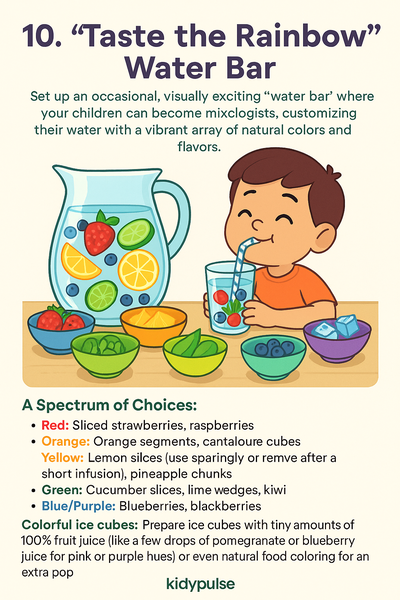
10. "Taste the Rainbow" Water Bar
Set up an occasional, visually exciting "water bar" where your children can become mixologists, customizing their water with a vibrant array of natural colors and flavors. For more ideas, check out these(https://kidypulse.com/us/blog/nutrition/colorful-rainbow-recipes-kids).
Make hydration a feast for the eyes!
- A spectrum of choices: Arrange small bowls containing different colored fruits, perfect for infusion or just adding to their glass. For example:
- Red: Sliced strawberries, raspberries.
- Orange: Orange segments, cantaloupe cubes.
- Yellow: Lemon slices (use sparingly or remove after a short infusion), pineapple chunks.
- Green: Cucumber slices, lime wedges, kiwi.
- Blue/Purple: Blueberries, blackberries.
- Colorful ice cubes: Prepare ice cubes with tiny amounts of 100% fruit juice (like a few drops of pomegranate or blueberry juice for pink or purple hues) or even natural food coloring for an extra pop.
- Creative concoctions: Let your children choose their "colors" to add to their water, creating their own personalized "rainbow drink." This combines the fun of infusion with a strong visual theme and immediate customization. This "Taste the Rainbow" approach directly appeals to a child's love for bright colors, often exploited by sugary, artificially colored drinks. By using the natural vibrancy of fruits, you're offering a healthy alternative that is just as visually stimulating and interactive. As they select different colored fruits, it also opens up opportunities for informal learning about where those colors come from and the nutrients they provide... This hands-on activity reinforces that healthy choices can be exciting and delicious, fostering a deeper appreciation for natural foods.
A Gentle Nudge: Spotting the Dry Spells
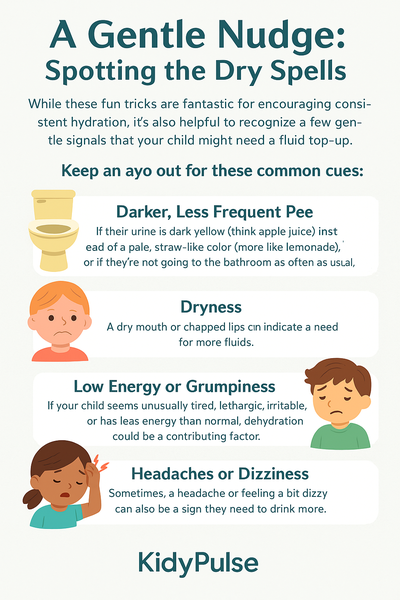
While these fun tricks are fantastic for encouraging consistent hydration and preventing dehydration, it's also helpful to recognize a few gentle signals that your child might need a fluid top-up. Remember, by the time a child actually says they're thirsty, they might already be a little dehydrated.
Keep an eye out for these common cues:
- Darker, less frequent pee: If their urine is dark yellow (think apple juice) instead of a pale, straw-like color (more like lemonade), or if they're not going to the bathroom as often as usual, it could be a sign.
- Dryness: A dry mouth or chapped lips can indicate a need for more fluids.
- Low energy or grumpiness: If your child seems unusually tired, lethargic, irritable, or has less energy than normal, dehydration could be a contributing factor.
- Headaches or dizziness: Sometimes, a headache or feeling a bit dizzy can also be a sign they need to drink more. Recognizing these early signs allows for timely intervention – simply offering more water or a hydrating snack. This knowledge can empower you to act proactively, preventing mild dehydration from becoming more noticeable. It's also worth noting the connection between hydration and your child's overall mood and cognitive performance. If you notice increased grumpiness or difficulty concentrating, ensuring they're well-hydrated can be a simple first step to help them feel their best.
Of course, by making water fun and readily available, you're already taking wonderful steps to keep them well-hydrated. If you ever have serious concerns about dehydration, such as if your child is extremely thirsty, very lethargic, confused, has sunken eyes, or is breathing rapidly, it's always best to seek medical advice promptly.
Conclusion – Cheers to Happy Hydration!

Keeping our children happily hydrated doesn't need to feel like an uphill climb. As you've seen, with a sprinkle of creativity, a dash of playfulness, and a whole lot of love, encouraging water intake can become an enjoyable and positive part of your family's daily life.
The wonderful thing about these ten tricks is their flexibility. Every child is unique, with their own preferences and personality. What sends one child racing for their water bottle might not capture another's attention in the same way. So, feel empowered to experiment! Try out a few of these ideas, mix and match them, and see what truly resonates with your little one. You're the expert on your child, and by observing what sparks their interest, you can tailor these strategies to create a hydration habit that sticks.
Here's to happy, healthy, and wonderfully hydrated kids who are energized, focused, and ready to take on the world, one fun, refreshing sip at a time!
Boost Fine-Motor Skills With Shape-Sorting Fun
Toddlers learn best through hands-on exploration, and few activities build fine-motor control as effectively as stacking and sorting. One simple way to nurture these skills is by adding a shape-sorting toy to your play-time rotation.
Why we love it: The Storio Geometric Angle Blocks set introduces little learners (ages 1-3) to colors, shapes, and early geometry while they practice grasping, matching, and balancing. The chunky wooden pieces are easy for tiny hands to hold, and the brightly painted angles keep children engaged far longer than a typical block tower.
Parents have told us they keep this set on a low shelf so kids can grab a piece whenever inspiration strikes—perfect for a quick, calming activity before dinner or during independent play.
FAQs About Kid-Friendly Hydration Tips
- Question:
Why is hydration important for kids? - Answer:
Hydration plays a crucial role in children's physical and mental development. It helps regulate body temperature, supports digestion, improves energy levels, and even boosts concentration and mood. Proper hydration also prevents fatigue and supports healthy skin. - Question:
How much water should a child drink daily? - Answer:
The amount varies by age, but general guidelines suggest: - Toddlers (1–3 years): ~4 cups (1 liter)
- Children (4–8 years): ~5 cups (1.2 liters)
- Older kids (9–13 years): 7–8 cups (1.6–1.9 liters)
These needs can increase with physical activity or hot weather. - Question:
What are some fun ways to get kids to drink more water? - Answer:
Try adding slices of fruits like strawberries or oranges for natural flavor. Use colorful straws, fun cups, or freeze fruit into ice cubes. Creating a hydration challenge or water-drinking chart can also motivate children to drink more. - Question:
Are flavored waters safe for children? - Answer:
Naturally flavored waters using fruits and herbs like mint are safe and healthy. Avoid store-bought options that contain added sugars, artificial flavors, or sweeteners unless specifically labeled kid-friendly and reviewed by a pediatrician. - Question:
Can I replace water with juice or milk for hydration? - Answer:
While milk and 100% fruit juice offer nutrients, water is still the best and most calorie-free option for hydration. Juice should be limited to 4–6 ounces per day, and water should remain the primary drink, especially during active play or hot days.
Sources used in this blog
Hydration, Hydration, Hydration – Wellness Tips – Temple Independent School District
Keeping Your Kids Hydrated - Northwest Family Clinics
Hydration tips for children | healthdirect
The Cognitive Effects of Proper Hydration - OSHA
How Much Water Should Kids Drink? - Children's Hospital of Orange County
Water Bottle For Kids School - Amazon.com
BPA Free Reusable & Spill-Proof Kids Water Bottles | Contigo
Foods With High Water Content | Sharp HealthCare
Get Your Kids Onboard with Water… Infused Water That Is ...
9 Infused Water Recipes You + Your Kids Will Actually Drink ...

Comments
No comments yet. Be the first to leave a comment!